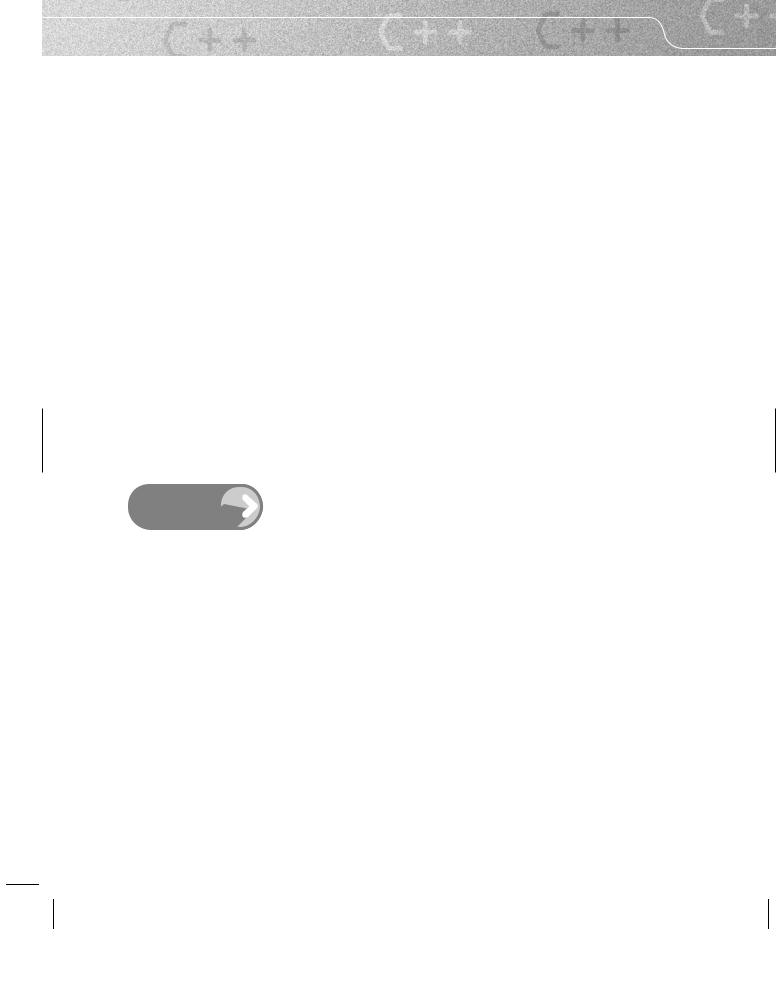
You Can Program In C++ (2006) [eng]
.pdf
208 |
CHAPTER 11 |
int main( ){
int array[ ] = {1, 3};
int const array_size(sizeof(array) / sizeof(int)); for(int i(0); i != array_size; ++i){
std::cout << "Element " << i << " is " << array[i] << ".\n";
}
}
3.Try arrays of some other types and experiment until you are reasonably happy you understand the results.
Arrays and Pointers
One of the design decisions for C++ was to make an effort to keep it compatible with C. Arrays cannot be passed around (or returned) by value in C; nor can they be in C++. C++ has an option to pass an array by reference, but that is limited to cases where the exact size of the array is known at the time we declare the function. For example:
void foo(int(& a_ref)[2]){
std::cout << sizeof(a_ref)/sizeof(int) << '\n';
}
This declares the parameter a ref as a reference to an array of two ints. We can call foo( ) with an argument that is an array of two ints, but not any other size of array of int.
This is a big limitation of using arrays. We do not want to have to provide a new version of a function for each possible size of array. C fixed the problem by using pointers. We can, for example, declare:
void send_out(std::ostream &, int * a, int array_size);
The definition might be:
void send_out(std::ostream & out, int * a, int array_size){ for(int i(0); i != array_size; ++i){
out << "The value of element " << i << " is " << a[i] << ".\n";
}
}
Here is a simple program that uses that function:
int main( ){
int array[ ] = {1, 3};
int const array_size(sizeof(array) / sizeof(int)); send_out(std::cout, array, array_size);
}
We have to pass the size of the array as an explicit argument because the function cannot deduce the size of the array. When we use the name of the array without subscripting, we get the address of the first element. C++ allows us to subscript a pointer; in other words, we can use a pointer object as if it is the name of an array. However, that places a great burden on the programmer, who must ensure that the subscript refers to an actual member of the array. This burden is yet another reason that experienced C++ programmers avoid using arrays when they can use an alternative C++ mechanism (the commonest being a std::vector).

POINTERS, SMART POINTERS, ITERATORS, AND DYNAMIC INSTANCES |
209 |
When a pointer points to an element of an array, we can increment and decrement the pointer (and add and subtract integer values from it) to move through the elements of the array. However, we must be careful about stepping off the ends. Even loading an invalid pointer value (such as attempting to print it out) is undefined behavior in C++. C++ provides two special cases to assist with working with pointers.
One Beyond the End
The address of storage one beyond the end of an object or array is always a valid address, in the sense that you are allowed to use the address. However, you must not attempt to access any object through such an address (pointer value) because there will not normally be a suitable object located at that address. For example:
int main( ){
int array[ ] = {1, 3};
int const array_size(sizeof(array) / sizeof(int)); std::cout << "The address beyond the start of array is "
<< array << ".\n";
std::cout << "The address beyond the end of array is " << array + array_size << ".\n";
}
However, you must not replace array + array size with &array[array size]. The first expression stays strictly within the limits of pointers and makes use of the special case that the address just beyond the end of an object is a valid address. The second version asks for the address of the object array[array size]; there is no such object, and consequently the code has undefined behavior.
Null Pointers
Because uninitialized pointers are generally accidents waiting to happen, C++ provides a special value that we can use when we do not have any other valid address to store in a pointer object. The actual value is up to the implementation, but whenever we set a pointer to zero (or use NULL from the <cstdlib> header), the compiler will substitute that special address. I like to think of that address as being equivalent to a safe landing zone on a hard drive; nothing is there, and so landing there does not cause any damage.
C++ adds some extra support to these null pointers by providing that they convert to false when our code requires a bool value. All other pointer values (addresses) convert to true.
Dynamic Instances
If it were not for the need to deal with dynamically created objects (ones explicitly created while the program is running), we could probably have avoided studying pointers in this book and have left them as a topic for an advanced book.
Languages that support object-orientation have more need than most to support objects created in response to runtime decisions. We will see in the next chapter that we sometimes need the ability to select the exact type of an object during the execution of a program. In addition, we may need to control the lifetime of an object rather than leaving such issues to be dealt with because a variable has gone out of scope.
Languages such as C allow the programmer to acquire a block of raw memory from an area called ‘the heap’ (using the 34malloc( ) family of library functions) and then ‘manually’ convert that memory into the object they wish to create. Other languages, such as Python, do all the work behind the scenes

210 |
CHAPTER 11 |
and leave the programmer little control. C++ provides a mechanism for creating new instances of a type in memory that has been provided from somewhere. The default mechanism for providing memory is from the heap.
That may sound complicated but it is actually easy in practice. All we need to do is write something such as:
mytype * mt_ptr(new mytype);
The important part above is new mytype, which results in two distinct things happening. First, the compiler arranges to get a suitable size and aligned block of memory for an instance of mytype. Just to be thoroughly confusing, C++ names this mechanism operator new and proceeds to provide ways in which the user can replace and/or overload that operator. We will not go there in this book; just note that it is possible, and that it is what programmers mean when they talk about ‘overloading new’. The second thing that happens is that an instance of mytype is then constructed in the provided memory, and a pointer to the object is returned by the new expression. In the above definition, mt ptr captures and stores the returned pointer. Another way of expressing that is to say that *mt ptr is the newly created instance of mytype.
The object we just created will continue to exist until we explicitly destroy it. We usually accomplish this by using the delete expression, whose action is the reverse of new. delete first calls the destructor for the object pointed to, and then uses operator delete (again, it can be replaced or overloaded) to return the raw memory to its source (usually the heap).
Playing Cards Revisited
Remember that in the last chapter we had a problem because card is an entity type without a default constructor. That meant that we could not have an array of card, because arrays require a default constructor (unless we can use direct initialization, as shown in the early part of this chapter). The following short program shows you how we can combine pointers and dynamic objects to work our way around this problem:
1 int main( ){
2try{
3int const cards(5);
4 card * d[cards] = { };
5for(int i(0); i != cards; ++i){
6d[i] = new card(card_value(i));
7}
8 std::random_shuffle(d, d + cards);
9for(int i(0); i != cards; ++i){
10d[i]->send_to(std::cout);
11std::cout << '\n';
12}
13for(int i(0); i != cards; ++i){
14delete d[i];
15}
16}
17catch(...){
18std::cerr << "An exception occurred.\n";
19}
20}

POINTERS, SMART POINTERS, ITERATORS, AND DYNAMIC INSTANCES |
211 |
W A L K T H R O U G H
Line 3 allows us to use a small number of cards for our initial development and then replace it with a full pack later on if we want to. Line 4 defines an array of pointers to card called d and makes it safe by initializing them to null pointers (that is the effect of the = when applied to an array of pointers).
Lines 5 –7 loop through the array, on each pass creating a dynamic card, whose address is stored. Note that we can choose which constructor we use with new.
Line 8 uses the library function random shuffle( ) (declared in the <algorithm> header) to shuffle the elements of d. The arguments passed to random shuffle( ) provide a pointer to the first element of the array and a pointer to the one beyond the end of the array. The whole of the design for handling collections of objects (in this case an array of pointers) is based on being able to provide an iterator (a pointer in the case of an array) to the first element and an iterator to one beyond the end. Without the guarantee that the address one beyond the end of an array is valid, we would not have been able to apply the standard algorithms to simple arrays.
Lines 9 –12 output the shuff led cards in order of their positions. Line 10 demonstrates how we can use a pointer to access a member function.
We call -> the arrow operator, and we read it as ‘points to’. If you prefer, you could write (*d[i]).send to(std::cout) (that is, get the instance pointed to by d[i] and apply send to(std::cout) to it). However, the arrow operator makes the code clearer and so we would normally prefer it in cases like this one.
Lines 13 –15 loop through d, destroying each of the card instances. If we did not do this, the destructors for the instances would not be called. An important guideline when dealing with dynamic objects is that every time you use the new expression you must also use the delete expression. You should also avoid creating dynamic arrays with new, as that is a significantly different operation, involving multiple calls of the constructor. C++ provides a distinct mechanism for handling dynamic arrays, which is largely defunct in high-level code. These days we use std::vector<> when we want a dynamic array, and all the fiddly details are handled for us. (Only people such as the implementers of std::vector<> need to spend time understanding the subtleties of dynamic arrays in C++.)
Exception Safety
When we create dynamic objects, we face a problem with their destruction if an exception occurs. How do we ensure that the dynamic objects will be destroyed? There are several solutions to this. Before going on to a more general solution, here is one that works in simple cases where we have complete control. Note that it relies on the guarantee that an attempt to delete a null pointer will result in nothing happening.
We need to ensure that if an exception occurs, the catch clause releases any dynamically allocated resources (usually memory, but there are other resources we may need to release). As a rule, we use destructors for releasing resources, but sometimes we can avoid that. Here is our program rearranged to handle the dynamically created instances of card even if an exception happens:
1 int main( ){
2int const cards(5);
3 card * d[cards] = { };
4try{
5for(int i(0); i != cards; ++i){
6 d[i] = new card(card_value(i));

212 |
CHAPTER 11 |
7}
8 std::random_shuffle(d, d + cards);
9for(int i(0); i != cards; ++i){
10d[i]->send_to(std::cout);
11std::cout << '\n';
12}
13}
14catch(...){
15std::cerr << "An exception occurred.\n";
16}
17for(int i(0); i != cards; ++i){
18delete d[i];
19}
20}
This is exactly the same code that we had before except that I have moved some statements outside the try block. Lines 2 and 3 consist of exception-safe definitions: they will not cause an exception. However, we need the declaration of d to be outside the try block, because d must remain in scope after the end of that block. I have moved the loop that deletes the dynamic instances of card to the end of the program (after the catch(...) clause) so that this cleanup code will run even if an exception fires.
1. Create a project. Enter, compile, and run the above program. Note that its TASK 11.3 output is indistinguishable from the previous version.
2. Insert the line
throw std::exception( );
between lines 7 and 8. Test the program and note that the cleanup happens immediately after we finish constructing the dynamic instances of card.
3.Move the insertion of throw std::exception( ); back to between lines 4 and 5. Test the resulting program. Note that the destructor for card is never called – which is what we would hope for, because we threw an exception before any instances of card were constructed.
4.Insert the line
if(i == 2) throw std::exception;
between lines 6 and 7 in the version of the program from step 1. Test the resulting program and note that there is a destructor called for every constructed card.
Redesigning deck
I am going to call the redesigned class pack to avoid confusion, because I am going to change the public interface in ways that are incompatible with my previous design:

POINTERS, SMART POINTERS, ITERATORS, AND DYNAMIC INSTANCES |
213 |
class pack{ public:
static int const cards = 52; pack( );
pack(std::istream &); ~pack( );
void shuffle( ); card & next( ); void top( );
void copy_from(pack const &); card & get_card(int pos)const;
private:
pack(pack const &);
pack & operator=(pack const &); int position;
card * pack_[cards];
};
Remember that one of the identifying properties of an entity is its identity. That is why next( ) and get card( ) return a card&. Otherwise, the public interface of pack is much the same as that for deck.
Implementing pack
There are a few trivial bits that we might as well get out of the way before we look at the more complicated pieces:
int const pack::cards; // define the static member void pack::top( ){
position = 0; // reset to top of pack
}
void pack::shuffle( ){
std::random_shuffle(pack_, pack_ + cards); // wrapper for random_shuffle
}
Next, we have the two constructors. We have to cater for exceptions happening during construction, and C++ does not, at the time of writing, provide a mechanism for initializing an array of pointers to null pointers as part of a constructor. The method we used in ordinary code is not available for constructor initializer lists. However, we need our pointers to be safe to delete even if the process of creating instances of card fails. The first line of the body of each constructor sets all the pointers in the array to null. We then enter a loop to create the cards we need. If that process fails for any reason, we destroy any already-constructed instances of card before rethrowing the exception (that is what the throw by itself means). If no exception interferes, the constructor completes (and because we are instrumenting our code, the final line of each constructor body reports successful completion).
pack::pack( ):position(0), pack_( ){ try{
for(int i(0); i != cards; ++i){ pack_[i] = new card(card_value(i));
}
}
catch(...){

214 CHAPTER 11
std::cerr << "An exception occurred.\n"; for(int i(0); i != cards; ++i) delete pack_[i]; throw;
}
std::clog << "Pack of cards created.\n";
}
The pack ( ) in the constructor initializer list initializes the array to null pointers. It is a special syntax introduced late in the standardization of C++ to provide explicit zero-initialization of an entity.
pack::pack(std::istream & in):position(0), pack_( ){ try{
for(int i(0); i != cards; ++i){
card_value const val(fgw::read<card_value>(in)); pack_[i] = new card(val);
}
}
catch(...){
std::cerr << "An exception occurred.\n"; for(int i(0); i != cards; ++i) delete pack_[i]; throw;
}
std::clog << "Pack of cards created from input.\n";
}
fgw::read<> relies on an overload of operator>>( ) for the type we are reading.
The destructor is straightforward. However, it is no longer a trivial destructor; it has real work to do before reporting that it has run. This is a typical example of using a destructor to release resources acquired during construction:
pack::~pack( ){
for(int i(0); i != cards; ++i) delete pack_[i]; std::clog << "Pack of cards destroyed.\n";
}
Experienced programmers may recognize that the semantics of the copy from( ) function below is copy assignment. I do not want to allow assignment because it is too easy to make a mistake and copy unintentionally. However, we have to consider all the problems of copying. Look at the for loop. First, I create a dynamic copy of the next card and hang on to it with a temp. That action might fail with an exception. However, if it does, the two instances of pack are in stable conditions. The destination one may now be an incomplete copy, but it is in a destructible state. Once I have created my copy of the next card, I can safely destroy the one it is replacing and transfer the pointer held in temp to the now vacated position in the array pack . This is a short function, but work through it carefully, making sure you understand how it works.
void pack::copy_from(pack const & source){ for(int i(0); i != cards; ++i){
card * temp(new card(source.pack_[i]->get_value( )));
delete pack_[i]; // remove current item pack_[i] = temp;
}
position = source.position;
}

POINTERS, SMART POINTERS, ITERATORS, AND DYNAMIC INSTANCES |
215 |
When I came to implement pack::next( ) I had to first store a reference to the next card before updating the pointer. Notice how I have dereferenced the pointer to get the card instance. I chose to do this at the first opportunity because the compiler may be able to do a better job if it can see what I want as early as possible.
card & pack::next( ){
card & next_card(*pack_[position]); ++position;
if(position == cards) position = 0; return next_card;
}
card & pack::get_card(int pos)const{ if(pos < 0 or pos > (cards - 1))
throw std::range_error("No such position in pack"); return *pack_[pos];
}
Finally, I am providing an overload for operator<< for pack (the corresponding input is by using the second constructor). There is rather more detail to this function, so I would not define it inline. You will need to provide a suitable declaration in card.h and add this definition to card.cpp.
std::ostream & operator<<(std::ostream & out, pack const & d){ for(int i(0); i != pack::cards; ++i){
out << d.get_card(i) << '\n';
}
return out;
}
1. Add the definition of pack to card.h and the implementation to card.cpp. TASK 11.4  (You may find it helpful to declare a smaller value for pack::cards while you are trying the code out; I used 5 instead of 52). Make sure that
(You may find it helpful to declare a smaller value for pack::cards while you are trying the code out; I used 5 instead of 52). Make sure that
card.cpp compiles. Now try this simple test program:
int main( ){ try{
pack p; pack p1;
p1.shuffle( ); p1.copy_from(p); p.shuffle( );
}
catch(...){
std::cerr << "An exception occurred\n";
}
}
Experiment with this code until you are sure you know how it works.
2.Modify the above program to test input from an input stream. As std::cin is the only input stream you have available, you will definitely need to reduce pack::cards to less than the 52 cards in a complete pack.

216 |
CHAPTER 11 |
Smart Pointers
We often wish that a pointer would do more for us. For example, when a pointer is holding the address of a dynamically created object, it would be nice if the object were automatically destroyed when the pointer goes out of scope.
C++ provides us with the basics to create user-defined types (classes) whose instances have pointer-like semantics. At a minimum, such classes provide an overload for operator-> (the points-to operator) and operator* (the dereference operator, not the multiplication operator). In addition, we can provide overloads for operator++ (the increment operator) and operator-- (the decrement operator). We can also support addition and subtraction of integer values.
In general, a smart pointer is any user-defined type that provides overloads for operator-> and operator*. Such types are almost invariably written as class templates, so that they can be used to manage the addresses of a wide variety of types. They are notoriously difficult to write correctly (and so I will not be tackling that issue in this book). The difficulty is exemplified by std::auto ptr<>, which is the only freestanding smart pointer in the current Standard Library; std::auto ptr<> achieves rather less than it was originally designed to do, and the flaws were discovered too late in the standardization process for correction.
std::auto ptr<> was designed to manage the lifetimes of single dynamic objects (std::vector<> largely replaces any requirement for dynamic arrays). However, it was also intended for use in collections, to handle dynamic instances (e.g. pack’s array of card*), so that we would not need to handle destruction of the dynamic instances explicitly. Unfortunately, there is an issue with the semantics of std::auto ptr<>
that makes it unsafe to use such ‘algorithms’ as sort( ) and random shuffle( ) on a collection of them. There are other widely available smart pointers, such as shared nptr from Boost (see http://www. boost.org/libs/smart ptr/smart ptr.htm). Some of these will be added to the Standard Library at its next release (circa 2009). Many of these, such as counted ptr<> and shared ptr<>, will work safely
in a standard container.
Here is a simple program to demonstrate the use of std::auto ptr<>:
int main( ){
std::auto_ptr<card> ex(new card(card_value(3))); std::clog << "Example of using the overloaded ->: "; ex->send_to(std::clog);
std::clog << '\n';
std::cout << "Example of dereferencing: " << *ex << '\n';
}
std::auto ptr<> is declared in the <memory> header; this may have been included indirectly with
one of the other headers you need for this program, but that will not always be the case.
Note that this program behaves almost the same as one with the first statement replaced by:
card * ex(new card(card_value(3)));
However, if you look carefully, you will see that the raw-pointer version never destroys the card object.
Guidelines for Using std::auto ptr<>
std::auto ptr<> has non-standard copy semantics: it passes the address it holds to the copy. That means that any copying of a std::auto ptr<> (by using its copy constructor or its copy-assignment operator) changes the copied object. The intention was to provide a smart pointer type that would relay responsibility for an object so that only one instance would be responsible for the life of an object at any moment in a program. This seductive idea has unintentional side effects. The following three guidelines will keep you away from them:

POINTERS, SMART POINTERS, ITERATORS, AND DYNAMIC INSTANCES |
217 |
•Do not pass it by value. In other words do not write functions that take a std::auto ptr<> by value; always use a reference parameter.
•Be careful about returning a std::auto ptr<>. Return it by reference if it was provided as a reference parameter (ensuring that the original retains responsibility for the address); return it by value if it is a local variable in the current function (transferring the address it contains to the caller).
•Do not use collections (arrays, std::vector<>, etc.) of std::auto ptr<>. The algorithms that manipulate collections are designed to work with standard copy semantics (where copying does not change the original).
Iterators
Like so many other terms, the term ‘iterator’ in C++ has a different meaning from that used in computer science. An iterator in C++ is an object or value that locates another object. Raw pointers and most smart-pointer types are examples of C++ iterators.
C++ has a hierarchy of iterator concepts. All iterators support operator-> and operator*; in other words, an iterator is always a smart pointer (unless it is a raw pointer).
In addition, a forward iterator supports operator++ (to move from one instance to the next one). Forward iterators can be useful for input and output where we can only move forward through a sequence.
A bidirectional iterator is a forward iterator that also supports operator-- (to move to the previous instance). The iterators for std::list<> (which is a doubly linked list template type) are examples of bidirectional iterators, because they allow stepwise traversal of a list in either direction. However, a singly linked list type would normally only provide forward iterators.
Random-access iterators are bidirectional iterators that also support operator+(int) and operator- (int). A raw pointer is a random-access iterator.
In general, it is the responsibility of the programmer to ensure that invalid iterators are not used. This includes knowing such things as the possible consequences of appending new elements to a std::vector<>. The designers of std::vector<> stipulated that the elements must be held in contiguous storage. The consequence of this requirement is that adding new elements can result in relocating the storage used for the existing elements. Here is a code snippet to demonstrate the problem:
1 std::vector<int> v(1);
2 v[0] = 1000;
3 std::vector<int>::iterator iter(v.begin( ));
4 std::cout << *iter << '\n';
5 for(int i(0); i != 100; ++i) v.push_back(i);
6 // at this point iter is no longer valid and must not be dereferenced
Line 1 declares v to be a vector of int with a single element. Line 2 initializes this single element to 1000. Line 3 declares iter as an iterator for a vector of int and initializes it to hold the location of the first (and only) element of v. Line 5 loops 100 times to add another 100 elements to the end of v. That process will almost certainly result in moving the location v is using to store its elements. As a result, iter will no longer hold the location of the first element of v.
If you want to turn the above code into a program and are willing to accept all responsibility for the consequences, you can replace line 6 with a repeat of line 4. However, if the result is reformatting your hard drive, do not say I did not warn you. As we are dealing with ints the result of this ‘dangerous’ program is relatively risk-free (I saved all my work and tried it myself). However, doing the same with a user-defined type could have bad consequences, so learn not to do it.
This particular kind of invalidation of operators is specific to std::vector<> (and std::string). The other standard containers, such as std::deque<>, do not have the problem of moving their elements to new locations. Nonetheless, it is usually a poor idea to hang on to an iterator value for any length of time. Refresh the values immediately before use.
